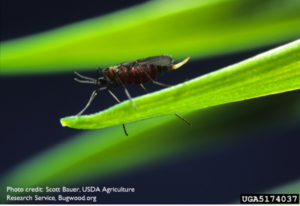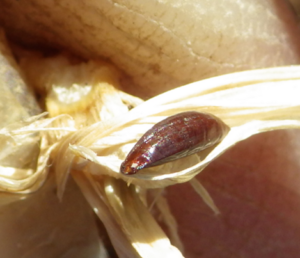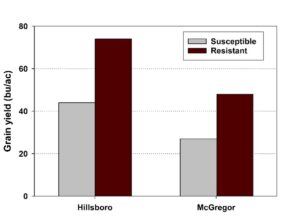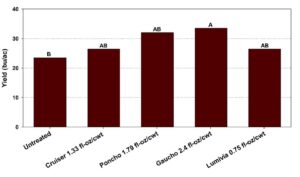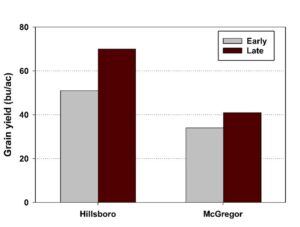1.Tyler Mays, Extension Agent-IPM Hill and McLennan Counties, tyler.mays@ag.tamu.edu
David Kerns, Associate Department Head & State IPM Coordinator
David Drake Extension Agent-IPM-Hunt and Grayson Counties
Hessian fly in wheat has been a significant issue for wheat producers across much of Eastern Texas for the last two years. During this time there have been numerous fields that have been plowed under due to poor stands caused by extreme Hessian fly populations. As we prepare to plant the 2024 wheat crop now is a great time to think about management options that can help mitigate the impact Hessian fly.
Biology:
The Hessian fly is a small fly that resembles a small mosquito and is closely related to the sorghum midge. The adult fly is roughly. 1/8th of an inch in size, with a dark thorax, head, and wings and a reddish abdomen (Figure 1). The average egg lay per female is 200 but can lay as many as 400. Eggs are laid on the upper leaf surface between the leaf veins and are elongated and reddish orange (Figure 2). Depending on the temperature the egg can hatch in 3 to 10 days. Newly hatched larvae are reddish orange in color and follow the leaf blade down to move behind the sheath to develop a feeding site in the crown or just above a node in jointed wheat. After the larvae establish a feeding site it develops the characteristics creamy white color with a translucent green stripe down it back (Figure 3). The maggot continues to feed for 2-3 weeks, passing through two larval instars, before reaching the third instar which develops into the puparium or flaxseed stage (Figure 4). During the third instar the Hessian fly larvae do not feed, and depending on the temperature can pupate and emerge as an adult in 7 to 35 days or go into aestivation (over summer) or diapause (overwinter). Adult emergence is impacted by weather, with 70°F being the temperature of highest activity, and high humidity and/or moisture in the surrounding environment. Depending on the temperatures the Hessian fly is exposed to, they can go from egg to adult in as little as 35 days when the temperature is 70°F.
| Figure 1. Adult female Hessian fly. Photo credit: Scott Bauer, USDA-ARS. | Figure 2. Hessian fly eggs on a wheat leaf.
|
| Figure 3. Hessian fly maggot with the characteristic color pattern of creamy white with a translucent green stripe down the back. | Figure 4. Hessian fly puparium, “flax seed” in a wheat stem.
|
Hosts:
The Hessian fly’s preferred host plant is wheat but has been known to infest other small grains like barley, rye, and triticale. The Hessian fly also has a wide range for wild grass hosts like timothy, jointed goatgrass, western wheatgrass, and even quackgrass. It is important to note that oats are not a suitable host for Hessian fly.
Damage:
The larval stage is the only life cycle stage that feeds on the host plant, and it is only the first two instars that feed. Early in the season, when plants are still small and trying to develop the resources needed for tillering, is when wheat is the most susceptible to significant damage. Damage from Hessian fly come from the feeding by the maggot on the stem and can cause leaves to be wider and darker green, stunted growth, reduced grain yields, poor kernel fill, and even tiller death. Previous research conducted in Georgia concluded that significant yield losses can occur when 5-8% of tillers are infested in the fall, or when 13-20% tillers are infested in the spring.
Management Options:
Since the larval stage of the Hessian fly is spent mostly behind the leaf sheath, it is protected from any foliar insecticide applications, and currently there are no curative control options available once the plant becomes infested. Most management options are implemented prior to or at planting including variety selection, insecticide seed treatments, crop rotation, and planting date adjustments. Additionally, how wheat stubble is managed post-harvest can influence the Hessian fly pressure for the next crop. There are foliar insecticides like lambda-cyhalothrin and other pyrethroids labeled for Hessian fly management in wheat, but this management option is not recommended. For foliar applications to be effective they must be made to target the presence of adults and/or eggs. Previous research conducted in the Southeastern United States has shown these applications to provide inconsistent results, and with the number fly of generations we experience here in Texas, timing is difficult and may be cost and logistically prohibitive.
Variety Selection: There is a lot of variability in the way commercial wheat varieties respond to being infested with Hessian fly. There are commercial varieties that are known to be highly susceptible to Hessian fly, varieties that are highly resistant to Hessian fly, and wheat varieties that tend to be tolerant. Hessian fly resistance in wheat is through antibiosis and is conferred by one or more of the 37 identified resistance genes commonly referred to as H genes. To date there have been 16 different biotypes of Hessian fly identified that vary in their ability to survive on certain H-genes. Because of this, how a variety with an H-gene responds to a Hessian fly infestation depends on the gene present in the plant and the biotype(s) present in the field. Planting varieties with H-genes is the most reliable management option for Hessian fly in wheat, depending on selecting H-genes active towards the encountered biotype. There are several varieties that are referred to as tolerant and lack the presence of a H-gene. In tolerant varieties plants will still be infested, but these varieties are still able to yield while being infested. The mechanism of Hessian fly tolerance is still somewhat unknown, but it is thought that tillering capacity may increase a variety’s tolerance to Hessian fly.
| Figure 5. Impact of Hessian fly resistance on grain yield averaged across two planting dates in Hillsboro, TX and McGregor, TX in 2023.
|
Planting varieties with resistance or tolerance to Hessian fly has been the most effective management option. Research conducted during 2022-2023 showed that a resistant variety can yield roughly 20 bushels more than a susceptible variety (Figure 5). However, these resistant varieties should not be the only varieties planted. This is because H-genes that confer resistance to Hessian fly can break down over time. This is driven by selection pressure for those Hessian fly biotypes that can survive on the deployed H-genes. When a single variety or even a single H-gene is widely deployed across a region for multiple years, the biotype frequency will shift to be predominantly the biotype that can survive on that variety or H-gene and can render the resistance genes ineffective after some time. To maintain the effectiveness of the H-genes we have, multiple varieties with different resistance genes should be planted across an area, and incorporating varieties that are tolerant can also help prolong the effectiveness of our current known H-genes.
| Figure 6. Impact of insecticide seed treatments on grain yields averaged across two planting dates in McGregor, Texas, 2023. |
Insecticide Seed Treatments: Insecticide seed treatments can be used in small grains to manage early-season insect pest such as aphids, wireworms, fall armyworms, and Hessian fly. Currently there are two groups of insecticide seed treatments, the neonicotinoids, which include products like Cruiser, Poncho, and Gaucho; and the diamides like Lumivia CPL which has the same active ingredient as Vantacor. By utilizing an insecticide seed treatment, early-season Hessian fly can be managed to help the crop get off to a good start. Using a neonicotinoid seed treatment may not prevent yield loss from Hessian fly in Texas because of the multiple generations per year, but any protection to help the crop get established and start tillering sooner than later will have a beneficial impact on the production of the field. Length of control by these insecticides will depend on product selection, rainfall/soil moisture encountered after planting, and insect pressure. A general rule of thumb for neonicotinoid seed treatments is that they will provide control for roughly 30 days after planting. Recent research trials looking at insecticide seed treatments saw a positive yield response with neonicotinoid seed treatments, with imidacloprid (Gaucho) yield significantly more than the untreated check in one of the two locations (Figure 6). There are several generic insecticide seed treatments, some of which are premixes of an insecticide and a fungicide. When treating seed with an insecticide seed treatment it is important to ensure you are applying the maximum amount of the insecticide as possible to ensure adequate control is achieved. Some people have questioned the price of implementing insecticide seed treatments, but the use of them is greatly beneficial to a wheat crop as it can also control early-season soil dwelling pests and aphid infestations which are an important vector for viral diseases like Barley Yellow Dwarf Virus. By utilizing a neonicotinoid-based insecticide seed treatment you help protect the plant from attack by multiple insect pests which can help the crop get off to a good start.
Planting Date: Adjusting your date of planting can help avoid Hessian fly infestations with a fly free date, which is a date that after a crop is planted is safe from being infested or experiencing significant damage from the Hessian fly. Sadly, due to our mild weather during the late fall and winter in Texas, we do not have a fly free date because the Hessian fly can be active all year. Delaying planting later than normal can help reduce the impact of Hessian fly on your crop by helping the field(s) avoid potential early fall broods. This management practice is not perfect, as the weather during the fall and winter can impact how active adults are in the fall. Research
| Figure 7. Impact of planting date on grain yields when exposed to Hessian fly during the 2023 season in Hillsboro and McGregor. |
conducted in McGregor and Hillsboro recently showed a significant impact when wheat was planted a month later (Figure 7). When delaying planting it is also important to look at the variety’s maturity class and vernalization requirement, since delayed planting will reduce the length of season and the possible number of chilling hours.
Crop Rotation: Crop rotation can provide some reduction in the Hessian fly pressure, as this insect survives the summer months in the infested crop residue. Due to them surviving in wheat stubble, wheat planted behind a suitable host plant can be highly susceptible to having severe Hessian fly damage. Rotating away from a suitable host for 1 year will greatly reduce the Hessian fly population by causing them to migrate to find a food source. Crop rotation is not perfect, and its success is dependent on the crop rotation of other nearby fields. Once way crop rotation fails to reduce the Hessian fly pressure is a neighboring field was planted to wheat the previous year, and when flies emerge in the fall they move into your field. Crop rotation has additional benefits other than minimizing Hessian fly risk, as it can also reduce the risk of having issues with other pests and diseases.
Foliar Insecticides: There are several insecticides like lambda-cyhalothrin and other pyrethroids that are labeled for Hessian fly. These products are labeled for control of either the adults or newly hatched larvae before they move behind the leaf sheath. Currently, there are not any products that can control the larval stage after it develops a feeding site behind the leaf sheath. Currently it is not recommended to make foliar applications specifically targeting Hessian fly, as results conducted in the Southeastern United States has shown inconclusive data. It is also likely that these management options would be cost prohibitive, as there would need to be multiple applications made throughout the year to achieve control. Additionally, targeting both the adult and egg stages are hard due to their size, and length of lifetime exposed. Adults are small and difficult to identify without magnification and sweep nets to sample fields to identify Hessian fly adults. The second issue with targeting adults is that they only live for 2-3 days after they emerge from the puparium, and you would need to have a quick turnaround from detection to spraying for it to be effective. Targeting the egg stage is difficult because the eggs are small, and difficult to see without magnification. The egg stage only lasts for a few days to about a week depending on the weather conditions so extensive scouting is required to adequately detect them. The maggot also does not spend much time exposed to the environment after hatching from the egg, usually moving behind the leaf sheath within 24 hours of hatching. This narrow window of adults present, eggs present, and hatched maggots exposed to the spray make it difficult to time the application and get consistent control.
Residue Management: Since the Hessian fly survives the summer months in the infested crop residue, how you manage the crop residue after harvest can impact the Hessian fly pressure for the following year. Tillage can reduce the number of adults that can successfully emerge, thus reducing the overall Hessian fly pressure in the fall. For tillage to be successful at reducing Hessian fly pressure, infested crop residue should be buried to about 3-4 inches deep. This may not be a feasible option for many producers due to soil conditions usually being dry after harvest, and some producers practicing reduced tillage or some other soil conservation practice. Prescribed burns of infested fields may help reduce the Hessian fly pressure for the following crop, however, it does have limitations and negative side effects. Although it could potentially be effective, the fire does not burn hot enough to kill the puparia that are below the soil surface. Prescribed burns of crop residue have negative effects like losing the nutrients that are tied up in the residue that would have been released back into the soil as it decayed, loss of organic matter being added to the soil, and increase risk of erosion by removing roots masses and crop residue that would have protected the soil from wind and water erosion.
Many producers have the tendency to bale straw and other crop residues after harvest to help feed livestock over the winter months. If infested wheat stubble is baled after harvest will remove some of the Hessian fly puparia from the field, but they are able to survive the baling process and storage. Baling infested wheat stubble is not a good idea, as it can move a Hessian fly infestation into the area where you store your hay bales. Additionally, if you are purchasing wheat straw from someone it is important to inspect the bales to ensure they are not heavily infested with Hessian fly. This is especially important if you are buying bales for a different area of the state because they may have a different biotype that is virulent against the H-genes that have been effective in your area.
Hessian Fly Outlook 2023-2024:
Hessian fly issues tend to be cyclical, with heavy outbreaks like the ones we experienced the last two years occurring about every 10 years. The potential impact of Hessian fly in the fall can be predicted based on the weather in August and September. The Hessian fly tends to be a significant issue when August and September are cool and wet followed by a warm and dry October and November. Based on the current weather pattern it appears that we may not have as a significant Hessian fly pressure this year, but there is still plenty of time for our weather to change and allow for Hessian fly populations to build in early fall and if warm temperatures occur in winter and spring, we could still see a significant Hessian fly impact from these winter and spring broods which can still lead to significant crop lodging and yield loss. However, the current extended weather forecast is predicting a moderate to strong El Nino weather pattern. In Texas, this usually means a wetter and cooler winter which may be helpful in suppressing winter and spring Hessian fly brood emergence.
What Can I Do Now?
The best thing you can do at this point is to research how the varieties you selected respond to Hessian fly. This information can come from the seed company, seed dealer, and even neighboring farmers. The response of a variety to Hessian fly may vary across regions, and it is also recommended to visit with neighboring farmers about how different varieties have performed on their farms. Diversifying your varieties can also help minimize the risk for severe Hessian fly infestations. Choose varieties that have shown a good yield potential in your area, especially under high Hessian fly pressure. Select varieties with demonstrated resistance or tolerance to Hessian fly. By incorporating a mixture of resistant and tolerant varieties into your wheat production system, you can reduce the selection pressure for the biotypes that survive on the H-genes that are being deployed in your area.
The next thing you can do to minimize the impact of Hessian fly is to treat your seeds with a neonicotinoid insecticide seed treatment. There are systems that allow you to treat your seeds on-farm, or you can find a nearby commercial seed treatment facility. The next management option you can implement now is to delay planting dates based on the variety’s susceptibility to Hessian fly. Because wheat that is planted early in the year tends to be exposed to more fall broods, if you are planting in October, you should plant your longer maturing resistant varieties at this time and plant your tolerant and susceptible wheat varieties later in the fall to minimize the number of adult broods they are exposed to in the fall. The last thing we can do this year is monitor your fields closely. By monitoring your fields closely throughout the year, you can 1) identify fields in a timely manner that may not yield good due to Hessian fly, 2) to get an idea on how your varieties are holding up against Hessian fly, and 3) to identify where you have Hessian fly issues to help guide your management decisions in future years.
